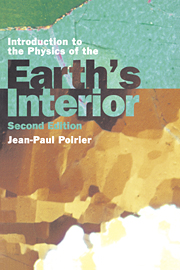Book contents
- Frontmatter
- Contents
- Preface to the first edition
- Preface to the second edition
- Introduction to the first edition
- 1 Background of thermodynamics of solids
- 2 Elastic moduli
- 3 Lattice vibrations
- 4 Equations of state
- 5 Melting
- 6 Transport properties
- 7 Earth models
- Appendix PREM model (1s) for the mantle and core
- Bibliography
- Index
Introduction to the first edition
Published online by Cambridge University Press: 05 June 2012
- Frontmatter
- Contents
- Preface to the first edition
- Preface to the second edition
- Introduction to the first edition
- 1 Background of thermodynamics of solids
- 2 Elastic moduli
- 3 Lattice vibrations
- 4 Equations of state
- 5 Melting
- 6 Transport properties
- 7 Earth models
- Appendix PREM model (1s) for the mantle and core
- Bibliography
- Index
Summary
The interior of the Earth is a problem at once fascinating and baffling, as one may easily judge from the vast literature and the few established facts concerning it.
F. Birch, J. Geophys. Res., 57, 227 (1952)This book is about the inaccessible interior of the Earth. Indeed, it is because it is inaccessible, hence known only indirectly and with a low resolving power, that we can talk of the physics of the interior of the Earth. The Earth's crust has been investigated for many years by geologists and geophysicists of various persuasions; as a result, it is known with such a wealth of detail that it is almost meaningless to speak of the crust as if it were a homogeneous medium endowed with averaged physical properties, in a state defined by simple temperature and pressure distributions. We have the physics of earthquake sources, of sedimentation, of metamorphism, of magnetic minerals, and so forth, but no physics of the crust.
Below the crust, however, begins the realm of inner earth, less well known and apparently simpler: a world of successive homogeneous spherical shells, with a radially symmetrical distribution of density and under a predominantly hydrostatic pressure. To these vast regions, we can apply macroscopic phenomenologies such as thermodynamics or continuum mechanics, deal with energy transfers using the tools of physics, and obtain Earth models – seismological, thermal, or compositional.
- Type
- Chapter
- Information
- Publisher: Cambridge University PressPrint publication year: 2000



